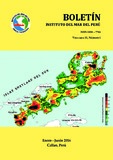Por favor, use este identificador para citar o enlazar este ítem:
https://hdl.handle.net/20.500.12958/3086Registro completo de metadatos
| Campo DC | Valor | Lengua/Idioma |
|---|---|---|
| dc.contributor.author | Ochoa López, Noemí | - |
| dc.contributor.author | Gómez Caballero, Olga | - |
| dc.contributor.author | Baylón, Maribel | - |
| dc.date.accessioned | 2017-01-25T15:22:32Z | - |
| dc.date.available | 2017-01-25T15:22:32Z | - |
| dc.date.issued | 2016 | - |
| dc.identifier.citation | Bol Inst Mar Perú 31(1), 2016: p. 114-120 | es_ES |
| dc.identifier.uri | https://hdl.handle.net/20.500.12958/3086 | - |
| dc.description | Boletín IMARPE vol.31, nº 1, 2016; p. 114-120 | es_ES |
| dc.description.abstract | Durante el verano austral 2007, se estudió la distribución y estructura de la comunidad fitoplanctónica en el estrecho Bransfield y la isla Elefante. Las muestras de agua se tomaron con botella Niskin a diferentes profundidades. El análisis cuantitativo se realizó según el método de sedimentación de Utermöhl. En la columna de agua en el Estrecho de Bransfield se identificaron 76 especies, de las cuales 53 fueron Diatomeas, 18 Dinoflagelados y 5 Microflagelados. Los grupos más abundantes fueron los microflagelados (76%), las diatomeas (21%) y los dinoflagelados (3%). Las especies dominantes fueron: Leucocryptos marina, Thalassiosira antarctica, Pseudonitzschia pseudodelicatissima, Pseudonitzschia seriata y Pronoctiluca pelagica. Las mayores abundancias de Diatomeas se encontraron alrededor de la isla Elefante asociadas a temperaturas >1 °C y salinidades <34,2 ups y la de los Microflagelados cerca de las islas Shetland del Sur y Elefante. El área más pobre en fitoplancton se encontró próxima a la península antártica. Verticalmente las mayores densidades de fitoplancton se ubicaron arriba de los 50 m, el índice de diversidad fue bajo, menor de 2,4 bits/cel y la similaridad entre muestras fue alta, mayor de 60%. A pequeña escala no hay una marcada variación temporal del fitoplancton. | es_ES |
| dc.description.abstract | ABSTRACT: The distribution and structure of the phytoplankton community in Bransfield Strait and Elephant Island were studied during Austral Summer of 2007. The seawater samples were collected using a Niskin bottle at different depths. The quantitative analysis was performed by the Utermöhl sedimentation method. 76 species of microalgae were identified in the water column of Bransfield Strait: 53 diatoms, 18 dinoflagellates and 5 microflagellates. In terms of abundance, the most representative groups were microflagellates (76%), diatoms (21%) and dinoflagellates (3%). The dominant species were Leucocryptos marina, Thalassiosira antarctica, Pseudonitzschia pseudodelicatissima, Pseudonitzschia seriata y Pronoctiluca pelagica. The highest abundance levels of diatoms were recorded surrounding Elephant Island and associated with temperatures >1 °C and salinities values <34.2 ups, while the largest abundance of microflagellates was recorded nearby South Shetland and Elephant islands. The poorest area in phytoplankton was determined in the vicinity of the Antarctic Peninsula. Vertically, the greatest densities of phytoplankton were located above 50 m. The diversity index was low, less than 2.4 bits/cel while the similarity among samples high, more than 60%. On a small scale there was no a marked temporal variation of phytoplankton. | - |
| dc.language.iso | spa | es_ES |
| dc.publisher | Callao | es_ES |
| dc.relation.ispartofseries | Boletín IMARPE;Vol. 31 n° 1, 2016 | - |
| dc.rights | info:eu-repo/semantics/openAccess | es_ES |
| dc.rights.uri | https://creativecommons.org/licenses/by/4.0/ | - |
| dc.source | Instituto del Mar del Perú - IMARPE | es_ES |
| dc.source.uri | Repositorio Digital IMARPE | es_ES |
| dc.subject | Fitoplancton | es_ES |
| dc.subject | Estrecho De Bransfield | es_ES |
| dc.subject | Isla Elefante | es_ES |
| dc.subject | Antártida | es_ES |
| dc.title | Fitoplancton del estrecho de Bransfield y alrededores de la isla Elefante durante el verano austral 2007 | es_ES |
| dc.title.alternative | Phytoplankton of Bransfield Strait and Elephant Island during austral summer 2007 | es_ES |
| dc.type | info:eu-repo/semantics/article | es_ES |
| Aparece en las colecciones: | Boletín 31(1), 2016 | |
Ficheros en este ítem:
| Fichero | Descripción | Tamaño | Formato | |
|---|---|---|---|---|
| Boletin 31(1)-14.pdf | 3,32 MB | Adobe PDF |  Visualizar/Abrir |
Este ítem está sujeto a una licencia Creative Commons Licencia Creative Commons

